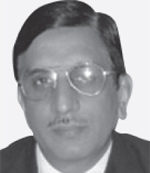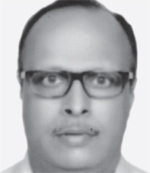Geospatially enabling mining sector in India
Speakers and Presentations

DR SANDEEP TRIPATHI
Chief Executive Officer
Orissa Remote Sensing Centre
Presentation on:Mining & Mineral Scenario : Odisha Perspective

DU VYAS
General Manager (Geo & Tech.)
Gujarat Mineral Development Corporation Ltd
Presentation on:Legislative Reform in Mining Sector and Mineral Exploration in India

Dr TS Sharma
Sr Geo Scientist
Dept of Mines and Geology
Rajasthan

GAUTAM BANDOPADHYAY
Director
MeaTech Solutions LLP

G.Srinivasan
Head
RRSC-Central
National Remote Sensing Centre

Vishnu Chandra
Deputy Director General & Group Head – Remote Sensing & GIS
National Informatics Centre
Introduction
India is the second fastest growing economy in Asia and one of the fastest growing in the world. This is creating an unprecedented demand for minerals and metals as building blocks and fuels to support the growth, industrialisation and urbanisation. Demand for minerals is robust in the country, putting mining in spotlight and necessitating the need for enhanced efficiency in this sector.
The country is witnessing a number of initiatives to spur the sector. The Mines and Minerals Development & Regulation (Amendment) Act 2015, aims to address the challenges facing the mining industry, provide impetus to the mining sector, encourage exploration and investment, simplify procedures and check illegal mining. It also makes provisions for the establishment of National Mineral Exploration Trust for regional and detailed exploration. Emphasis has been placed on a number of matters such as:
- Reconnaissance operations / prospecting operations
- E-auctions
- Improvement in procedure for grant of mineral concessions and to ensure co-ordination among agencies entrusted with according statutory clearances
- Maintenance of internet-based databases including development and operation of a mining tenement system;
- Minimising and mitigating adverse environmental impacts
- Promoting restoration and reclamation activities
The geospatial benefits
The mining industry is primarily dependant on data. Information and spatial reference are essential through all phases of mineral production, from exploration through construction, operation and mine site closure. Mines have more dynamic assets which are under constant pressure by natural and economic forces. Geospatial data allows planners to prepare for the staged development of a mine and react rapidly to slope hazards or when actual ore grades differ from expected. In the background of increasing demand and diminishing deposits, discovering new sources ahead of the competition is the key for miners. In addition to exploration, remote sensing data can also help monitor the progress of mining and waste depositing on dumps.
Further, geospatial is also at the core of the focus areas of MMDR Act. Geospatial technologies such as aerial, geophysical or geochemical surveys and geological mapping, geographic information system, surveying, remote sensing, positioning, laser scanning, LiDAR, have been proven to be essential to the various activities under the purview of the Act, including reconnaissance and prospecting operations, tenement systems, exploration, e-auctions, environmental and safety concerns, co-ordination among agencies.
Seminar: Geospatially enabling mining sector in India
Understanding the increasingly critical role of efficiency in the mining sector in socio-economic development and the role of geospatial technology in achieving these objectives, Geospatial Media & Communications is organising the seminar “Geospatial Enabling Mining Sector in India,” during GeoSmart India 2016, March 1-3, 2016, India Expo Centre & Mart, Greater Noida.
Programme Objectives
- Bring together the diverse stakeholders of mining in the country to facilitate exchange of knowledge, technology and ideas on role of geospatial technology in effective and efficient mining practices and creating the most conducive environment for technology uptake and transfer
- Present the diverse applications of geospatial technology through presentations by technology leaders and experts and how it can contribute to efficient mining practices in the country
- Showcase best practices of technology use through case studies by user departments
- Bring out user challenges and draw out possible solutions
Programme benefits
The symposium will offer the following benefits to the users attending the seminar:
- Provide an insight into applications of geospatial technology in various stages of mining
- Improve understanding of the value and analysis of spatial data and geographic methods of spatial analysis in water management
- Discussion on the requisites for successful implementation of the technology
- Provide a platform for interaction between various stakeholders to create the most collaborative environment for most efficient use of geospatial technology
- To address challenges faced and draw out possible solutions
- Discuss steps required towards capacity building
- Understand the value proposition of geospatial technology
- Deliberate on value-addition and real-time dissemination of data
- Discuss scientific applications of geospatial technology and topics involving data, visualization, standards and interoperability
Agenda
The seminar will feature three sessions:
- G-tech transforming mining sector
While the practice of extracting minerals from the earth is centuries old, the mining sector is undergoing tremendous transformation owing to various socio-economic factors. This session will explore the role of geospatial technology in facilitating the mining sector to stay with the times to meet the social, economic and legislative requirements. -
The geospatial enablers
The evolution in geospatial technologies is ensuring that the technology has the potential and a role to play in all stages of mining. This session will explore the numerous geospatial innovations that can be tools for mining organisations to enhance their efficiencies. -
Taking a lead with geospatial
This session will present case studies from various mining organisations on successful implementation of geospatial technologies in their processes and the benefits they have accrued.